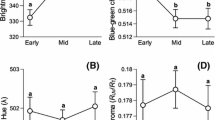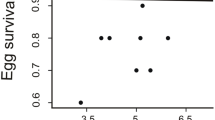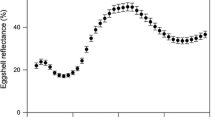Abstract
Although many avian eggs appear to be cryptically colored, many species also lay vibrant blue green eggs. This seemingly conspicuous coloration has puzzled biologists since Wallace, as natural selection should favor reduced egg visibility to minimize predation pressure. The sexual signaling hypothesis posits that blue green egg coloration serves as a signal of female quality and that males exert post-mating sexual selection on this trait by investing more in the nests of females laying more intensely blue green eggs. This hypothesis has received mixed support to date, and most previous studies have been conducted in cavity-nesting species where male evaluation of his partner’s egg coloration, relative to that of other females, may be somewhat limited. In this study, we test the sexual signaling hypothesis in colonially nesting ring-billed gulls (Larus delawarensis) where males have ample opportunity to assess their mate’s egg coloration relative to that of other females. We used correlational data and an experimental manipulation to test four assumptions and predictions of the sexual signaling hypothesis: (1) blue green pigmentation should be limiting to females; (2) extent of blue green egg coloration should relate to female quality; (3) extent of blue green egg coloration should relate to offspring quality; and (4) males should provide more care to clutches with higher blue green chroma. Our data provide little support for these predictions of the sexual signaling hypothesis in ring-billed gulls. In light of this and other empirical data, we encourage future studies to consider additional hypotheses for the evolution of blue green egg coloration.



Similar content being viewed by others
References
Alonso-Alvarez C, Tella JL (2001) Effects of experimental food restriction and body-mass changes on the avian T-cell-mediated immune response. Can J Zool 79:101–105
Andersson M (1994) Sexual selection. Princeton University Press, Princeton, NJ
Aviles JM, Soler JJ, Perez-Contreras T (2006) Dark nests and egg colour in birds: a possible functional role of ultraviolet reflectance in egg detectability. Proc R Soc Lond B 273:2821–2829
Baicich PJ, Harrison CJO (1997) A guide to the nests, eggs, and nestlings of North American birds, 2ndnd edn. Academic, San Diego
Bakken GS, Vanderbilt VC, Buttermer WA, Dawson WR (1978) Avian eggs: thermoregulatory value of very high near-infrared reflectance. Science 200:321–323
Boersma D, Ryder JP (1983) Reproductive performance and body condition of earlier and later nesting ring-billed gulls. J Field Ornith 54:374–380
Bolton M (1991) Determinants of chick survival in the lesser black-backed gull—relative contributions of egg size and parental quality. J Anim Ecol 60:949–960
Brown KM (1995) Does blood-sampling ring-billed gulls increase parental desertion and chick mortality. Colon Waterbird 18:102–104
Buck CL, O'Reilly KA, Kildaw SD (2007) Interannual variability of black-legged kittiwake productivity is reflected in baseline plasma corticosterone. Gen Comp Endocrinol 150:430–436
Cassey P, Ewen JG, Blackburn TM, Hauber ME, Vorobyev M, Marshall NJ (2008) Eggshell colour does not predict measures of maternal investment in eggs of Turdus thrushes. Naturwissenschaften 95:713–721
Cohen J (1988) Statistical power analysis for the behavioral sciences, 2nd edn. Erlbaum, New York
Colegrave N, Ruxton GD (2003) Confidence intervals are a more useful complement to nonsignificant tests than are power calculations. Behav Ecol 14:446–450
Conover MR (1989) Parental care by male–female and female–female pairs of ring-billed gulls. Colon Waterbird 2:148–151
Conover MR, Miller DE, Hunt GL (1979) Female–female pairs and other unusual reproductive associations in ring-billed and California gulls. Auk 96:6–9
Cott HB (1948) Edibility of the eggs of birds. Nature 161:8–11
Cuthill IC (2006) Color perception. In: Hill GE, McGraw KJ (eds) Bird coloration, vol I. Harvard University Press, Cambridge, MA, pp 3–40
Darwin C (1871) The descent of man, and selection in relation to sex. Murray, London
Davis AK (2005) Effect of handling time and repeated sampling on avian white blood cell counts. J Field Ornith 76:334–338
Ding ZK, Xu YQ (2002) Purification and characterization of biliverdin IXα from Atlantic salmon (Salmo salar) bile. Biochemistry (Moscow) 67:927–932
Falchuk KH, Contin JM, Dziedzic TS, Feng Z, French TC, Heffron GJ, Montorzi M (2002) A role for biliverdin IXα in dorsal axis development of Xenopus laevis embryos. PNAS 99:251–256
Gosler AG, Higham JP, Reynolds SJ (2005) Why are birds’ eggs speckled? Ecol Lett 8:1105–1113
Grant MC (1991) Relationships between egg size, chick size at hatching, and chick survival in the whimbrel Numenius phaeopus. Ibis 133:127–133
Higham JP, Gosler AG (2006) Speckled eggs: water-loss and incubation behaviour in the great tit Parus major. Oecologia 149:561–570
Hipfner JM, Gaston AJ (1999) The relationship between egg size and posthatching development in the thick-billed murre. Ecology 80:1289–1297
Hoyt DF (1979) Practical methods of estimating volume and fresh weight of bird eggs. Auk 96:73–77
Jackson WM (1992) Estimating conspecific nest parasitism in the northern masked weaver based on within-female variability in egg appearance. Auk 109:435–443
Kaur H, Hughes MN, Green CJ, Naughton P, Foresti R, Motterlini R (2003) Interaction of bilirubin and biliverdin with reactive nitrogen species. FEBS Lett 543:113–119
Kennedy GY, Vevers HG (1976) A survey of avian eggshell pigments. Comp Biochem Physiol B 55B:117–123
Kilner RM (2006) The evolution of egg colour and patterning in birds. Biol Rev Camb Philos Soc 81:383–406
Kitaysky AS, Wingfield JC, Piatt JF (1999) Dynamics of food availability, body condition and physiological stress response in breeding black-legged kittiwakes. Funct Ecol 13:577–584
Krist M, Grim T (2007) Are blue eggs a sexually selected signal of female collared flycatchers? A cross-fostering experiment. Behav Ecol Sociobiol 61:863–876
Lack D (1958) The significance of the colour of Turdine eggs. Ibis 100:145–166
Lahti DC (2005) Evolution of bird eggs in the absence of cuckoo parasitism. Proc Natl Acad Sci U S A 102:18057–18062
Lahti DC (2008) Population differentiation and rapid evolution of egg color in accordance with solar radiation. Auk 125:796–802
Lessells CM, Boag PT (1987) Unrepeatable repeatabilities—a common mistake. Auk 104:116–121
Lopez-Rull I, Celis P, Gil D (2007) Egg colour covaries with female expression of a male ornament in the spotless starling (Sturnus unicolor). Ethology 113:926–933
Lundberg CA, Väisänen RA (1979) Selective correlation of egg size with chick mortality in the black-headed gull (Larus ridibundus). Condor 81:146–156
Martinez-de la Puente J, Merino S, Moreno J, Tomas G, Morales J, Lobato E, Garcia-Fraile S, Martinez J (2007) Are eggshell spottiness and colour indicators of health and condition in blue tits Cyanistes caeruleus? J Avian Biol 38:377–384
McAldowie AM (1886) Observations on the development and the decay of the pigment layer on birds’ eggs. J Anat Physiol 20:225–237
Meathrel CE, Ryder JP (1987) Intraclutch variation in the size, mass and composition of ring-billed gull eggs. Condor 89:364–368
Monaghan P, Nager RG, Houston DC (1998) The price of eggs: increased investment in egg production reduces the offspring rearing capacity of parents. Proc R Soc Lond B 265:1731–1735
Montgomerie R (2006) Analyzing colors. In: Hill GE, McGraw KJ (eds) Bird coloration, vol I. Harvard University Press, Cambridge, MA, pp 90–148
Morales J, Sanz JJ, Moreno J (2006) Egg colour reflects the amount of yolk maternal antibodies and fledging success in a songbird. Biol Lett 2:334–336
Moreno J, Osorno JL (2003) Avian egg colour and sexual selection: does eggshell pigmentation reflect female condition and genetic quality? Ecol Lett 6:803–806
Moreno J, Osorno JL, Morales J, Merino S, Tomas G (2004) Egg colouration and male parental effort in the pied flycatcher Ficedula hypoleuca. J Avian Biol 35:300–304
Moreno J, Morales J, Lobato E, Merino S, Tomas G, Martinez-de la Puente J (2005) Evidence for the signaling function of egg color in the pied flycatcher Ficedula hypoleuca. Behav Ecol 16:931–937
Moreno J, Lobato E, Morales J, Merino S, Tomás G, de la Puente JM, Sanz JJ, Mateo R, Soler JJ (2006a) Experimental evidence that egg color indicates female condition at laying in a songbird. Behav Ecol 17:651–655
Moreno J, Morales J, Lobato E, Tomás G, de la Puente JM (2006b) More colorful eggs induce a higher relative paternal investment in the pied flycatcher Ficedula hypoleuca: a cross-fostering experiment. J Avian Biol 37:555–560
Moss R, Watson A, Rothery P, Glennie WW (1981) Clutch size, egg size, hatch weight and laying date in relation to early mortality in red grouse Lagopus lagopus scoticus chicks. Ibis 123:450–462
Nakagawa S (2004) A farewell to Bonferroni: the problems of low statistical power and publication bias. Behav Ecol 15:1044–1045
Nakagawa S, Foster MT (2004) The case against retrospective statistical power analyses with an introduction to power analysis. Acta Ethol 7:103–108
Nakagawa S, Cuthill IC (2007) Effect size, confidence interval and statistical significance: a practical guide for biologists. Biol Rev 82:591–605
Norris K, Evans MR (2000) Ecological immunology: life history trade-offs and immune defense in birds. Behav Ecol 11:19–26
Ots I, Hõrak P (1996) Great tits Parus major trade health for reproduction. Proc R Soc Lond B 263:1443–1447
Parsons J (1970) Relationship between egg size and post-hatching chick mortality in herring gull (Larus argentatus). Nature 228:1221–1222
Ricklefs RE (1974) Energetics of reproduction. In: Paynter RA (ed) Avian energetics, vol 15. Nuttall Ornithological Club, Cambridge, pp 152–297
Royle NJ, Surai PF, Hartley IR (2001) Maternally derived androgens and antioxidants in bird eggs: complementary but opposing effects? Behav Ecol 12:381–385
Ryder JP (1978) Sexing ring-billed gulls externally. Bird-Banding 49:218–222
Ryder JP (1993) Ring-billed gull. In: Poole A, Stettenheim P, Gill F (eds) The birds of North America. The National Academy of Sciences, Philadelphia
Šálek M, Cepáková E (2006) Do northern lapwings Vanellus vanellus and little ringed plovers Charadrius dubius rely on egg crypsis during incubation? Folia Zool 55:43–51
Salvante KG (2006) Techniques for studying integrated immune function in birds. Auk 123:575–586
Sánchez JM, Corbacho C, del Viejo AM, Parejo D (2004) Colony-site tenacity and egg color crypsis in the gull-billed tern. Waterbirds 27:21–30
Scalise I, Durantini EN (2004) Photodynamic effect of metallo 5-(4-carboxyphenyl)-10,15,20-tris(4-methylphenyl) porphyrins in biomimetic AOT reverse micelles containing urease. J Photochem Photobiol A 162:105–113
Siefferman L, Navara KJ, Hill GE (2006) Egg coloration is correlated with female condition in eastern bluebirds (Sialia sialis). Behav Ecol Sociobiol 59:651–656
Soler JJ, Møller AP (1996) A comparative analysis of the evolution of variation in appearance of eggs of European passerines in relation to brood parasitism. Behav Ecol 7:89–94
Soler JJ, Navarro C, Contreras T, Aviles J, Cuervo J (2008) Sexually selected egg coloration in spotless starlings. Am Nat 171:183–194
Swynnerton CFM (1916) On the coloration of the mouths and eggs of birds. II. On the coloration of eggs. Ibis 4:529–606
Underwood TJ, Sealy SG (2002) Adaptive significance of egg coloration. In: Deeming DC (ed) Avian incubation: behaviour, environment, and evolution. Oxford University Press, New York, pp 280–298
Verboven N, Monaghan P, Evans DM, Schwabl H, Evans N, Whitelaw C, Nager RG (2003) Maternal condition, yolk androgens and offspring performance: a supplemental feeding experiment in the lesser black-backed gull (Larus fuscus). Proc R Soc Lond B 270:2223–2232
Victoria JK (1972) Clutch characteristics and egg discriminative ability of African village weaverbird Ploceus cucullatus. Ibis 114:367–376
Wallace AR (1889) Darwinism: an exposition of the theory of natural selection with some its applications. Macmillan, London
Zhao R, Xu GY, Liu ZZ, Li JY, Yang N (2006) A study on eggshell pigmentation: biliverdin in blue-shelled chickens. Poult Sci 85:546–549
Acknowledgments
We are very grateful to Jim Quinn for the advice, guidance, and logistical support he provided throughout this project. We thank M. Vujacic, S. Mai, and especially A. Mistakidis for their efforts in the field. The Doucet Lab provided insightful comments on the manuscript. We also thank anonymous reviewers and the editorial staff for their helpful suggestions. Our study was funded by an Explorer’s Club grant to D.H. and by research and equipment grants from the Natural Sciences and Engineering Research Council of Canada and the University of Windsor to S.M.D. This study was conducted under compliance of regulations provided by the Canadian Council on Animal Care.
Author information
Authors and Affiliations
Corresponding author
Additional information
Communicated by K. McGraw
Rights and permissions
About this article
Cite this article
Hanley, D., Doucet, S.M. Egg coloration in ring-billed gulls (Larus delawarensis): a test of the sexual signaling hypothesis. Behav Ecol Sociobiol 63, 719–729 (2009). https://doi.org/10.1007/s00265-008-0705-2
Received:
Revised:
Accepted:
Published:
Issue Date:
DOI: https://doi.org/10.1007/s00265-008-0705-2




